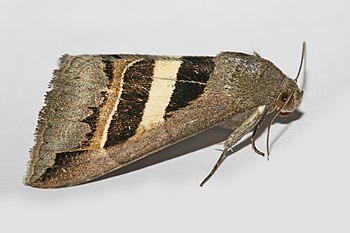The North Africa series of US Silver Certificates was issued in November 1942 in denominations of 1, 5, and 10 US dollars. The notes were similar to standard circulating silver certificates, except for their bright yellow seals. They were circulated amongst US troops in Europe and North Africa during World War II, and intended to be demonetized should the American forces be defeated.
 A cereal is a grass cultivated for the edible components of its grain, composed of the endosperm, germ, and bran. In their natural form (as in whole grain), they are a rich source of vitamins, minerals, carbohydrates, fats, oils, and protein, but when refined the remaining endosperm is mostly carbohydrate.
A cereal is a grass cultivated for the edible components of its grain, composed of the endosperm, germ, and bran. In their natural form (as in whole grain), they are a rich source of vitamins, minerals, carbohydrates, fats, oils, and protein, but when refined the remaining endosperm is mostly carbohydrate.
Pictured here are oats and barley, together with some products made from them.
 Hadji Ali (c. 1887–92 – 1937) was a vaudeville performance artist, thought to be of Egyptian descent, who was famous for acts of controlled regurgitation. His best-known feats included water spouting, smoke swallowing, and nut and handkerchief swallowing followed by disgorgement in an order chosen by the audience. In this 1926 image, he is performing his water spouting at the Egyptian Legation.
Hadji Ali (c. 1887–92 – 1937) was a vaudeville performance artist, thought to be of Egyptian descent, who was famous for acts of controlled regurgitation. His best-known feats included water spouting, smoke swallowing, and nut and handkerchief swallowing followed by disgorgement in an order chosen by the audience. In this 1926 image, he is performing his water spouting at the Egyptian Legation.
 Music recording certifications are typically awarded by the global music industry based on the total units sold or shipped to the retailers. These awards and their requirements are defined by the various certifying bodies representing the music industry in various countries and territories worldwide. The standard certification awards given consist of Gold (example pictured), Platinum, and sometimes Diamond awards, in ascending order; the UK also has a Silver certification, ranking below Gold. In most cases, a "Multi-Platinum" or "Multi-Diamond" award is given for multiples of the Platinum or Diamond requirements. Though all certifying bodies give awards for album sales or shipments, many also certify singles, paid digital downloads, music videos, music DVDs, and master ringtones. Additionally, some certifying bodies have separate threshold scales for works of domestic or international origins, varying genres, lengths, and formats.
Music recording certifications are typically awarded by the global music industry based on the total units sold or shipped to the retailers. These awards and their requirements are defined by the various certifying bodies representing the music industry in various countries and territories worldwide. The standard certification awards given consist of Gold (example pictured), Platinum, and sometimes Diamond awards, in ascending order; the UK also has a Silver certification, ranking below Gold. In most cases, a "Multi-Platinum" or "Multi-Diamond" award is given for multiples of the Platinum or Diamond requirements. Though all certifying bodies give awards for album sales or shipments, many also certify singles, paid digital downloads, music videos, music DVDs, and master ringtones. Additionally, some certifying bodies have separate threshold scales for works of domestic or international origins, varying genres, lengths, and formats.
 Grammodes geometrica is a species of moth in the genus Grammodes. It is found from the Mediterranean east through the Asian and Australasian tropics.
Grammodes geometrica is a species of moth in the genus Grammodes. It is found from the Mediterranean east through the Asian and Australasian tropics.
 The armies of the Mughal Emperor Humayun fighting those of Bahadur Shah of Gujarat in the year 1535, as depicted in anAkbarnama manuscript from the late 16th century. Bahadur, the Sultan of Gujarat, had allied with the Portuguese and planned an attack on the Mughals. To preempt such an attack, Humayun struck at Gujarat and conquered Mandu and Champanerbefore stopping his attack. Bahadur Shah was killed by the Portuguese two years later; Humayun was overthrown by Sher Shah Suri in 1540, retaking the throne fifteen years later.
The armies of the Mughal Emperor Humayun fighting those of Bahadur Shah of Gujarat in the year 1535, as depicted in anAkbarnama manuscript from the late 16th century. Bahadur, the Sultan of Gujarat, had allied with the Portuguese and planned an attack on the Mughals. To preempt such an attack, Humayun struck at Gujarat and conquered Mandu and Champanerbefore stopping his attack. Bahadur Shah was killed by the Portuguese two years later; Humayun was overthrown by Sher Shah Suri in 1540, retaking the throne fifteen years later.

